Top 11 New Technologies in AI: Exploring the Latest Trends
Nowadays, when the technological industry is developing every month, artificial intelligence (AI) stands as the major force that is progressing every minute and revolutionizing the way we live and work. Some difficult tasks that seemed impossible only a few years ago are now becoming an integral part of our reality. While scientists and engineers are arguing whether these rapid changes are good or bad, businesses should stay ahead of the curve in adopting the new technologies in AI in order to survive and grow in today’s constantly changing landscape.
In today’s world, new technologies in AI are no longer confined to the realms of science fiction. They are fully integrated into our daily lives. Despite many people thinking that they are behind the use of new technologies in AI, its impact takes part in the life of each individual, whether they have a mobile phone, an Internet connection, or simply buy something at the supermarket. The IT sphere has also witnessed intense changes. Everyone, from web developers and UI/UX designers to Android and iOS programmers, was forced to accept the new reality and modify their working processes.
In this article, we will reveal all the secrets that new technologies in AI hides, discuss its main trends and features, and find out how to successfully implement new technologies in AI in every business. From the remarkable advancements in natural language processing (NLP) and GPT to the impact of AI on the sales and marketing industries, we will explore the statistics, fascinating facts, and real-world business examples that successfully turn a new AI technology into profit.
In short, today we will take a look at the following topics:
- Did you know that the global artificial intelligence market is expected to reach USD 1345.2 billion by 2030? Sounds crazy, right? Yet, this is only one shocking example of the numbers AI brings to the function during the next decade, and today's article analyzes all of them (and more!).
- What is the difference between GPT 3.5 and GPT 4? To put it briefly, GPT 3.5 is aimed at automating content creation. GPT 4, in turn, is the next evolution that provides unprecedented language understanding and generation capabilities. Scroll down to find out more differences.
- Generative Adversarial Networks, also known as GANs, invented by Ian Goodfellow, employ an adversarial training process that has revolutionized the field of generative modeling and become one of the most game-changing solutions among new AI technologies.
- How does AI relate to healthcare? AI-driven medical imaging, including radiology and pathology, has undergone significant evolution, with the entire market predicted to reach $8.66 billion by 2027.
- There are plenty of new technologies in AI, such as reinforcement learning, predictive analytics, chatbots & virtual assistants, etc.
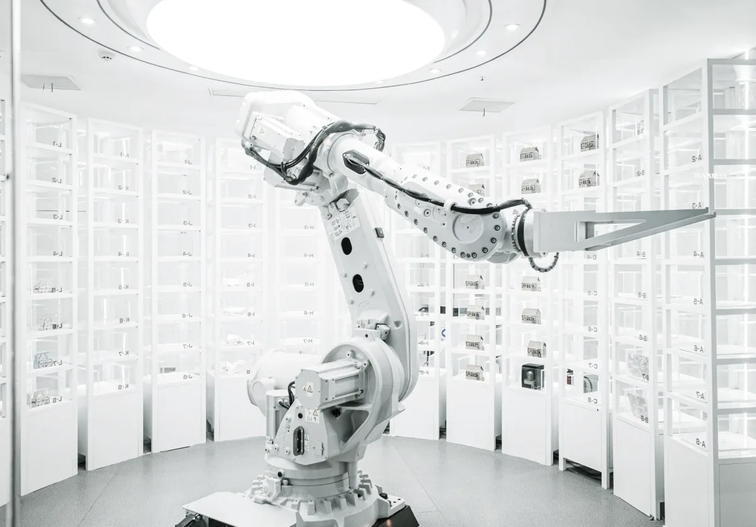
General Statistics Concerning New Technologies in AI
The high popularity of new technologies in AI impacts all industries of life. AI 3D modeling, healthcare, education, finance, retail, and many more spheres that we face every day. In healthcare and life sciences, the main responsibilities of the latest AI technology are to enhance diagnostic accuracy, enable personalized medicine, facilitate drug discovery, and maintain many other crucial activities. The finance industry uses AI-powered algorithms to improve risk assessment, detect fraud more effectively, and enhance customer service. Retail and eCommerce utilize new technologies in AI for demand forecasting, personalized marketing strategies, and optimizing supply chain operations. All in all, before discussing the new technologies in AI, let us show you some more statistical information that helps better understand the tendencies in the development of the AI industry.
To begin with, the MarketsandMarkets research states that the global artificial intelligence market is projected to reach USD 1345.2 billion by 2030, at a CAGR of 36.8% during the forecast period of 2023–2030. Such rapid growth is caused by its synergistic interaction with various other technologies. The convergence of artificial intelligence with other transformative technologies such as the Internet of Things (IoT), robotics, natural language processing (NLP), and computer vision enhances artificial intelligence capabilities and expands its application areas. We will describe all these technologies below.
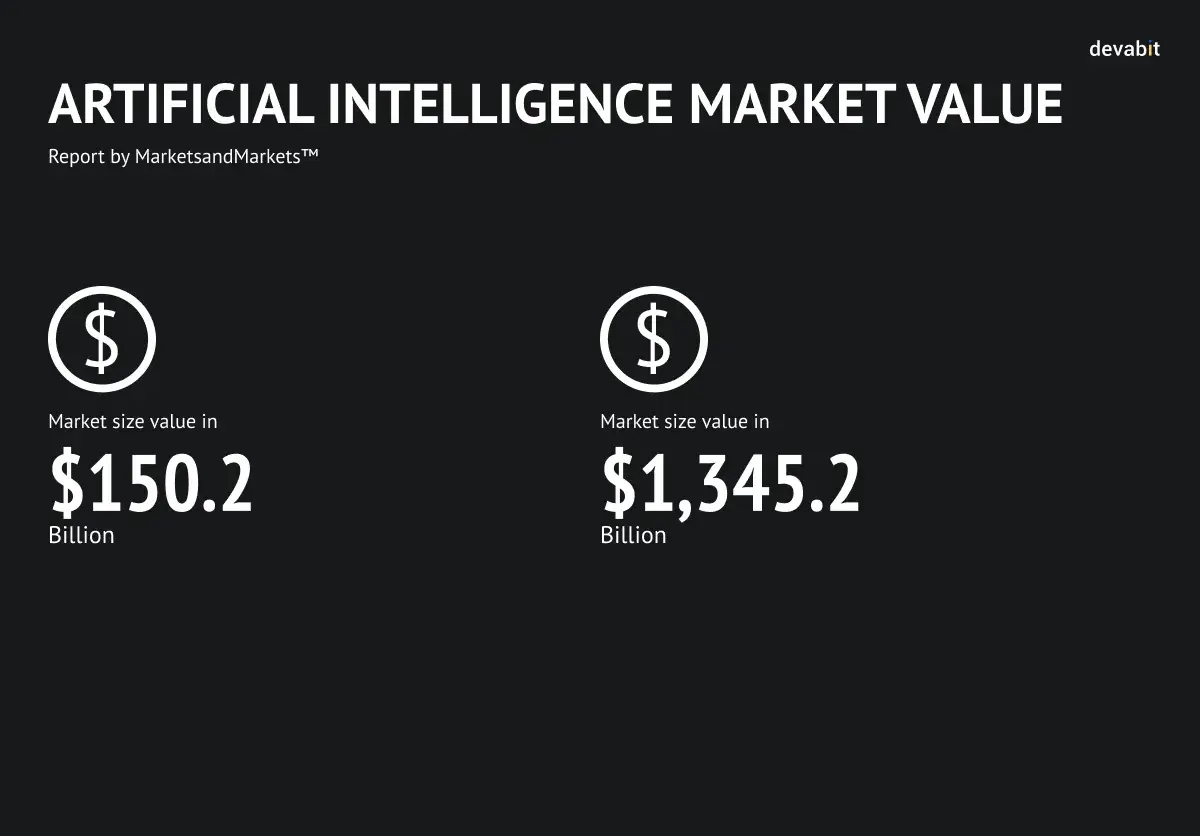
In comparison with the current market size of only USD 150.2 billion, it is really hard to imagine how fast new technologies in AI will develop in the near future. Moreover, the majority of segments that are predicted to be covered by the rapid development of AI news refer to technology and business. The MarketsandMarkets report also ensures that the artificial market has been divided by verticals into Retail & eCommerce, BFSI, Government & Defense, Healthcare & Life Sciences, Telecom, Energy & Utilities, Manufacturing, Agriculture, IT/ITeS, Media & Entertainment, Automotive, Transportation and Logistics, and others.
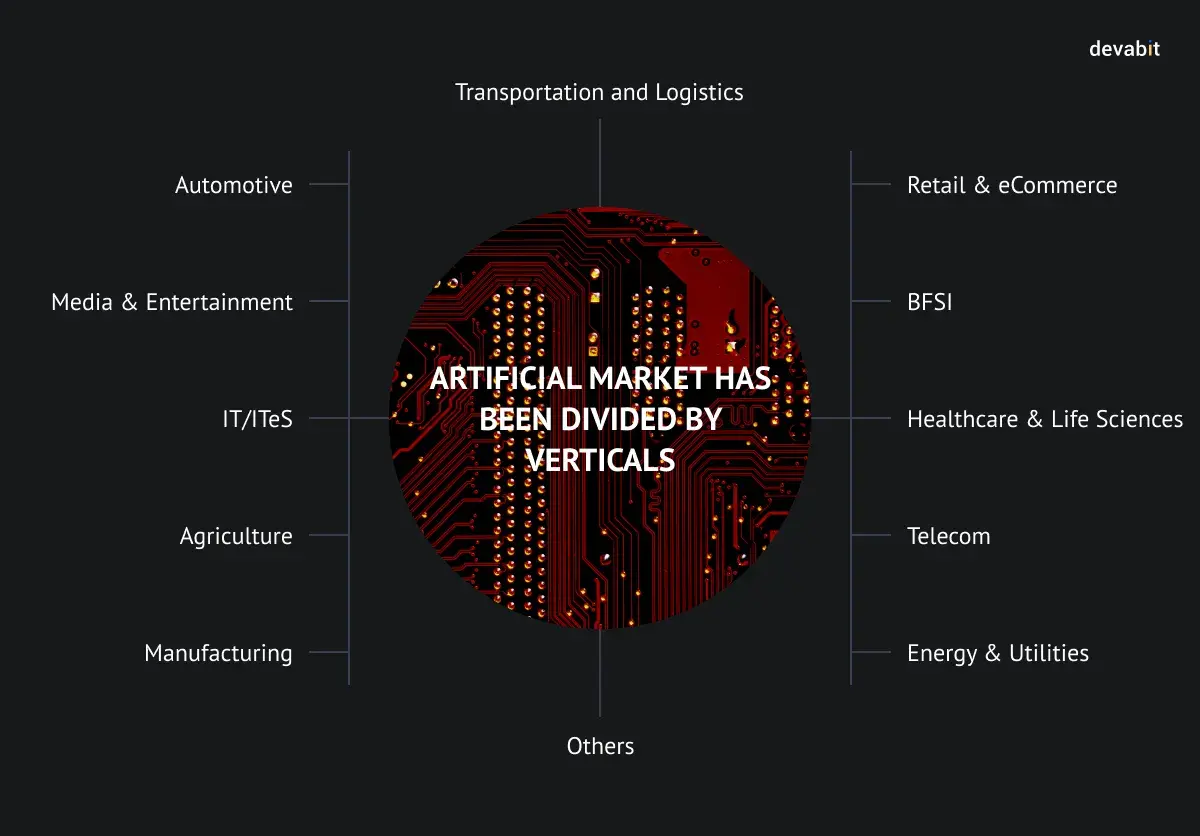
According to the Statista report, in 2022, the global total corporate investment in artificial intelligence reached almost 92 billion U.S. dollars, a slight decrease from the previous year. In 2018, the yearly investment in AI news saw a slight downturn, but that was only temporary. You can see that AI investment has increased more than sixfold since 2016, a staggering growth in any market. It is a testament to the importance of the development of the new technologies in AI around the world. Moreover, the Gartner survey of 2022 reveals that 80% of executives think that automation can be applied to any business decision. One-third of organizations are applying AI across several business units.
Are you afraid of losing your job because of new technologies in AI? The good news is that you definitely should not. The World Economic Forum ensures that AI's rise also significantly impacts the job market. By 2030, it is estimated that AI will create 70 million jobs worldwide while displacing 20 million, resulting in a net gain of 50 million jobs.
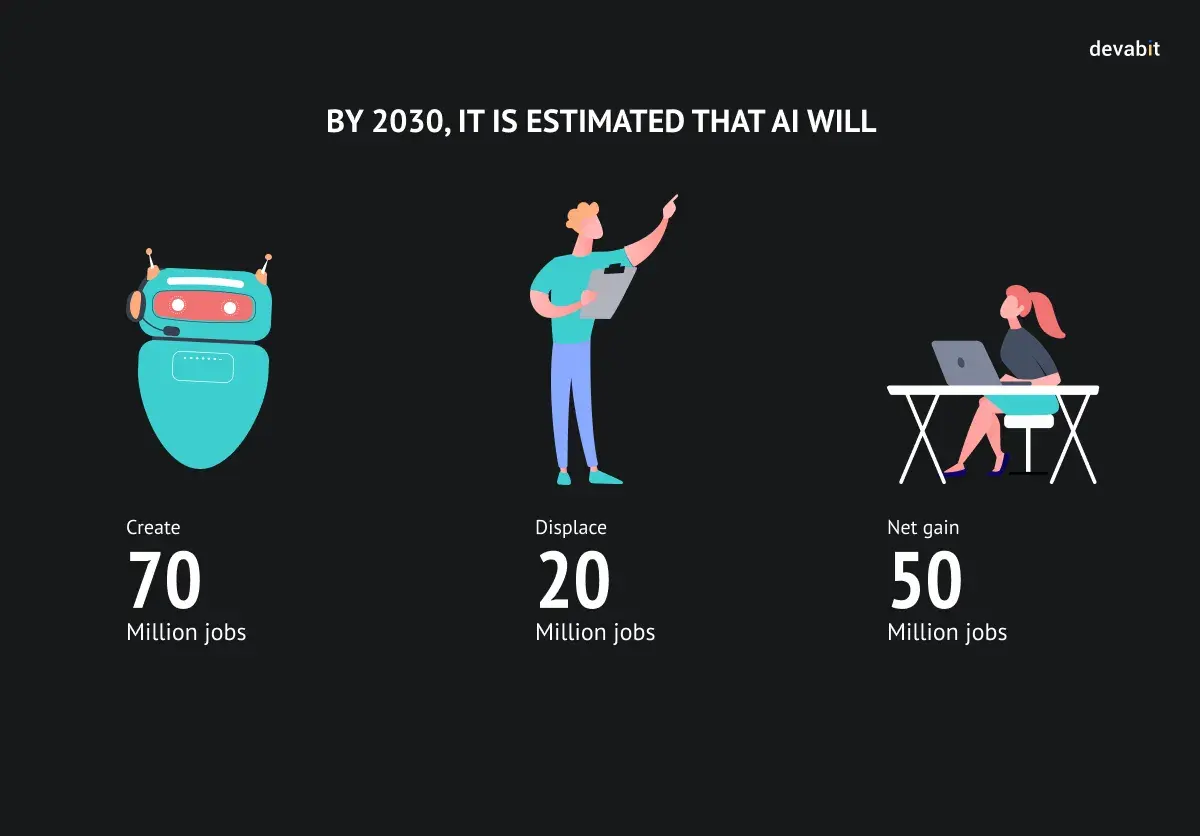
A recent LinkedIn US Executive Confidence Index Survey from June 2023 reflects an optimistic outlook: 47% of executives believe generative AI will boost productivity; 44% plan to augment their newest AI technology utilization in the coming year; and 40% view AI as a key to unlocking growth and revenue. Microsoft's 2023 Work Trend Index further bolsters this sentiment, revealing that a whopping 70% of individuals would gladly delegate tasks to AI to ease their workloads.

All in all, as the statistical data shows, the development of new technologies in AI will cause positive changes in the business market. Now let us tell you more about the main trends and new technologies in AI that will totally blow your mind.
1. New Technologies in AI: GPT-3.5/GPT-4
It is not a secret that GPT has become one of the most discussed breakthroughs among the latest AI technologies. But do you know the history of such a sensational technology? We will tell everything from the very beginning.
All the history takes its beginning with early examples like ELIZA in the 1960s and ALICE in the 1990s. These early chatbots used rule-based approaches and were limited in their ability to engage in meaningful conversations. In the 2010s, the world saw the emergence of AI-driven chatbots that incorporated machine learning and NLP techniques. Platforms like Facebook Messenger and Slack have popularized chatbots for business and consumer use.
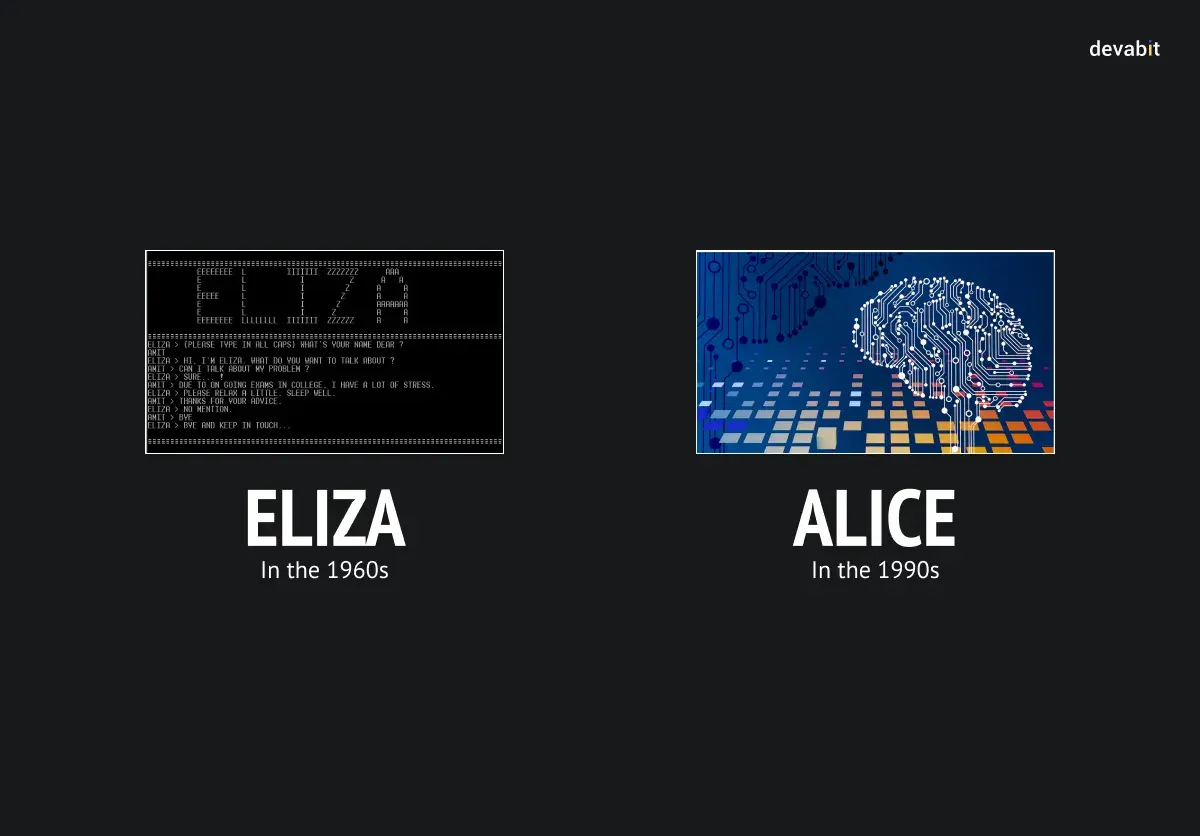
The breakthrough came with the development of deep learning models like GPT. GPT-1, introduced by OpenAI in 2018, marked a significant leap in chatbot capabilities. It could generate contextually relevant text, even though it had limitations. GPT-2, released in 2019, was known for its ability to generate human-like text on a larger scale. However, its release was initially controversial due to concerns about potential misuse. GPT-3, released in 2020, further improved upon its predecessors and gained widespread attention for its natural language understanding and generation capabilities.
GPT-3.5, the predecessor of GPT-4, boasted a staggering 175 billion parameters. To put this in perspective, it's more than 10 times the size of its predecessor, GPT-2, which had 1.5 billion parameters. GPT-3.5 demonstrated a remarkable ability to understand and generate human-like text. It could write essays, answer questions, and even create poetry. In fact, it was often challenging to distinguish its outputs from those of a human writer.
Have you mentioned that the last abstract was written by GPT? We do not think so.
New technologies in AI are developing extremely fast.
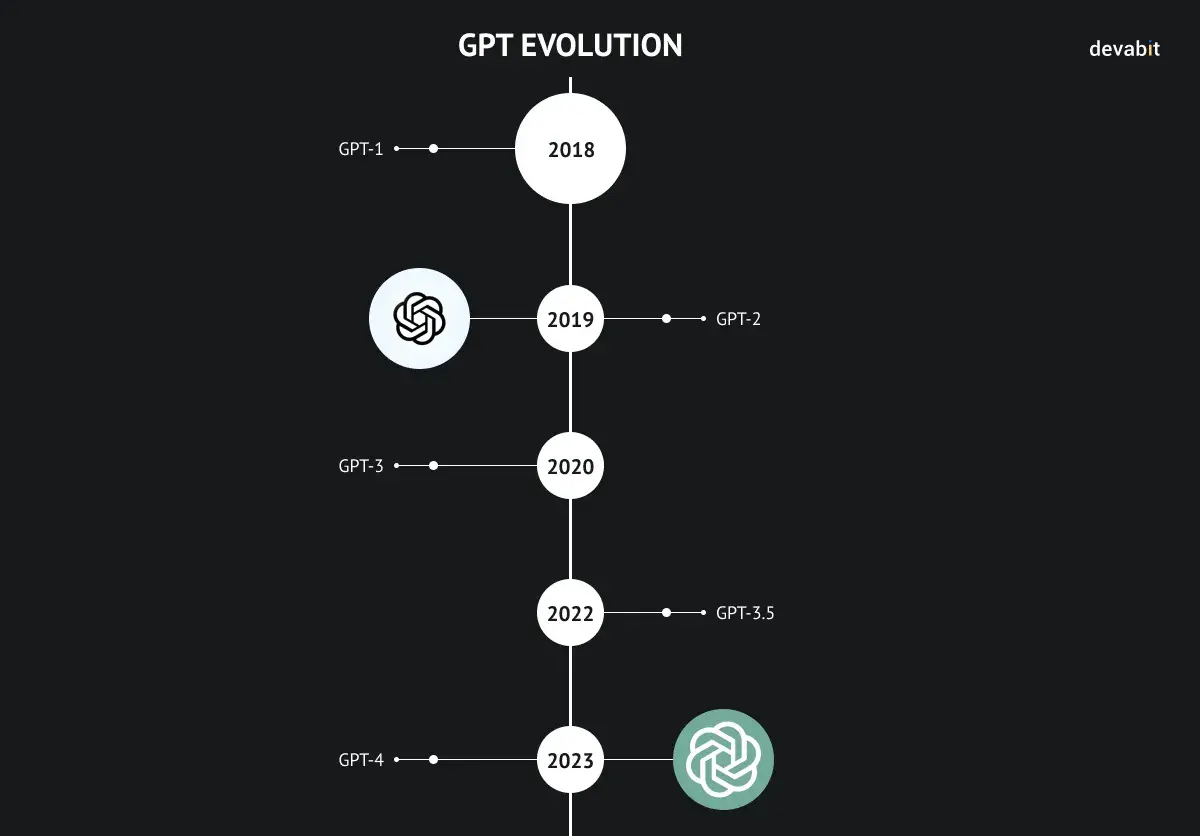
GPT-3.5 was harnessed by numerous businesses to automate content creation. In one instance, a media company used it to generate thousands of articles daily, drastically reducing the need for human writers.
GPT-4, the next evolution, boasts an even more astonishing parameter count, rumored to exceed 200 billion. This leap in scale promises unprecedented language understanding and generation capabilities. Businesses across various sectors are exploring the potential of GPT-4. Content generation, customer support, and virtual assistants are areas where GPT-4's capabilities are expected to shine.
GPT-3.5 and GPT-4 are just the beginning. The pace of AI model development suggests that even more capable language models are on the horizon, with implications for industries ranging from content creation to virtual assistants.
On November 6, 2023, CEO of OpenAI Sam Altman introduced a completely new version of Chat GPT that includes GPTs, Chat GPT Store, GPT-4 Turbo, and other new technologies in AI that we are going to describe in this article.
"OpenAI is the most advanced and most widely used platform in the world now," Sam Altman stated. For real, Chat GPT is used by people of all ages and professions all over the globe.
The fact that one technology is understandable to both a hundred-year-old man and a ten-year-old child cannot but impress. A lot of hard work stays behind such unbelievable success. “Today we have got about 2 million developers building on our API for a wide variety of use cases doing amazing stuff, over 92% of Fortune 500 companies building on our products, and about 100 million weekly active users now on Chat GPT,” ensures Sam Altman.
If you want to really dive into this magical world of the new technologies in AI and digital innovations, describe all tools that are available in the new GPT-4 Turbo, and consider the way to monetize new GPTs with the help of the Chat GPT Store - you should definitely read our new article.
2. New Technologies in AI: Generative Adversarial Networks (GANs)
Generative Adversarial Networks, or GANs, are the invention of Ian Goodfellow and his colleagues, introduced in 2014. Goodfellow's idea was to pit two neural networks against each other in a competitive framework: a generator network and a discriminator network. This adversarial training process revolutionized the field of generative modeling and has become one of the most game-changing solutions among the new technologies in AI.
GANs have grown in complexity over the years. The size of GAN models has increased exponentially, with models like BigGAN boasting an impressive 12 billion parameters, enabling the generation of high-resolution images with high levels of digitalization. Moreover, GANs have significantly advanced image super-resolution. For instance, "ESRGAN," an Enhanced Super-Resolution GAN, can upscale images with exceptional quality, making it invaluable in applications like medical imaging and enhancing visual content.
One interesting fact about the monetization of GAN is “Edmond de Belamy”, a portrait generated by GAN. It has become the first AI-generated artwork to be auctioned at Christie’s, selling for over $432,000.

If we consider the overall impact of GAN on the global economy, its value is quite substantial. The Statista report ensured that the worldwide generative AI market had a valuation of USD 10.3 billion in 2022, with projected growth to reach USD 136 billion by 2031. This growth is expected to maintain a compound annual growth rate (CAGR) of 33.2% throughout the forecast period from 2023 to 2031. Statista also mentions that the generative AI market share will likely expand rapidly in the next few years. The rising need for generative AI solutions in several sectors, such as healthcare, media, and entertainment, will drive market expansion as well as the development of new technologies in AI.

The future of GANs is forecast to have even more exciting developments. Researchers are exploring applications in 3D modeling, video generation, and beyond, with GANs continuing to redefine the boundaries of new technologies in AI.
3. New Technologies in AI: Explainable AI (XAI)
Explainable AI news started to develop when researchers began to seek ways to make AI more transparent and interpretable. XAI aims to provide insights into how AI models arrive at specific decisions, making it easier for humans to trust and understand AI-generated outcomes. It ensures that AI-driven decisions align with human values and expectations.
XAI uses various techniques that makes it one of the most unique models among all new technologies in AI. These include decision trees, linear models, and rule-based systems, which provide insights into how a model makes predictions.

Due to its increasing popularity, the global XAI market is on a growth trajectory. It is estimated to reach $1.2 billion by 2027, driven by the increasing adoption of the latest AI technology in industries like healthcare, finance, and manufacturing. The field is expected to evolve rapidly, addressing the challenges and making new technologies in AI more accessible for every individual.
4. New Technologies in AI: Natural Language Processing (NLP)
The history of Natural Language Processing (NLP) dates back to the 1950s, when researchers made their first attempts to teach computers to understand and generate human language. In the future, NLP will play a crucial role in the appearance and development of new technologies in AI.
Deep learning revolutionized NLP with models like recurrent neural networks (RNNs) and transformer-based models such as GPT and BERT. These models have achieved state-of-the-art results in a wide range of NLP tasks, from sentiment analysis to machine translation.
NLP has gone global, with multilingual models like XLM-R and mBERT capable of understanding and generating text in multiple languages. This global reach has unlocked new avenues for cross-cultural communication and business expansion. Virtual assistants like Siri, Alexa, and Google Assistant rely heavily on NLP for understanding and responding to user queries naturally. By 2024, the global virtual assistant market is projected to reach $25 billion.

In the business industry, NLP has transformed the way companies operate and engage with customers. NLP-powered chatbots and virtual assistants are revolutionizing customer support. They can provide instant responses to customer inquiries, handle routine tasks, and offer personalized assistance, improving customer satisfaction and reducing operational costs.
Of course, NLP models are used to generate high-quality written content, such as articles, product descriptions, and marketing materials. Additionally, NLP-driven SEO tools help businesses optimize their online content for search engines, improving their visibility and reach.
The future of NLP holds promise in areas like conversational AI new technology, document summarization, and AI-powered content creation. NLP will continue to empower businesses with tools for efficient communication and decision-making. All in all, as NLP technologies continue to advance, businesses that use language processing are better positioned to thrive in an increasingly competitive landscape.
5. New Technologies in AI: Healthcare
The integration of the latest AI technology into healthcare was an insecure but necessary step in the development of the whole industry. It resulted in patient care, diagnosis, and treatment improvement that became possible due to custom healthcare software solutions and new technologies in AI. Everything has started with the early AI applications in medical imaging. AI-driven medical imaging, such as radiology and pathology, has seen remarkable advancements. In 2020, the global AI in medical imaging market was valued at $1.13 billion, and it is expected to reach $8.66 billion by 2027.
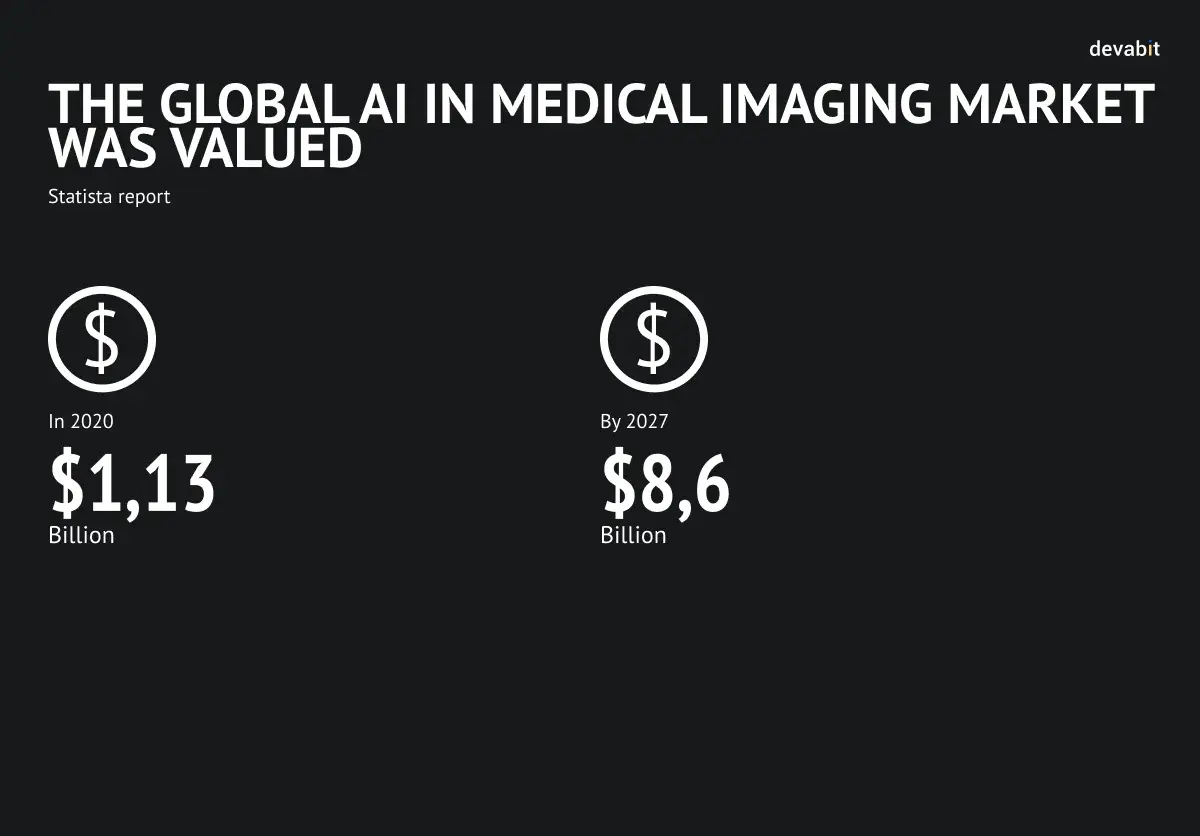
The benefits of the implementation of the new technologies in AI in the healthcare industry were groundbreaking. AI algorithms have demonstrated exceptional accuracy in diagnosing diseases like cancer and heart conditions. For instance, an AI model achieved 94% accuracy in detecting breast cancer in mammograms. Moreover, AI expedites drug discovery by predicting potential drug candidates and analyzing vast datasets. It reduces the time and cost associated with bringing new drugs to market, which can exceed $2.6 billion per drug.
The COVID-19 pandemic accelerated the adoption of telemedicine. AI-powered telehealth platforms enable remote consultations, making healthcare more accessible. According to Fortune Business Insights, the global telemedicine market was valued at $87.41 billion in 2022 and is projected to grow from $94.44 billion in 2023 to $286.22 billion by 2030. More information about telehealth and telemedicine can be found in our article about healthcare web development.

As we witness AI's remarkable impact on medical imaging, diagnostics, drug discovery, and telemedicine, it is clear that healthcare is on the brink of a digital revolution. With the potential to save lives, improve patient outcomes, and optimize healthcare delivery, new technologies in AI will be the real lifesavers in the future.
6. New Technologies in AI: Biometrics
With the help of new technologies in AI, biometrics has witnessed rapid growth. If in 2020 the biometrics market was valued at $22.68 billion, by the end of 2027 it is forecast to reach $85.96 billion. Now let us tell you more about the most popular methods of biometrics that have implemented the new technologies in AI.
Fingerprint recognition is one of the most widely used biometric methods. It's employed in various sectors, from smartphone unlocking to border control. The Future Market Insights report states that the fingerprint sensor market consists of 15% of the global biometric system market. The fingerprint sensors’ revenue by the end of 2022 was $3.7 billion, with the expected growth to be $10.2 billion by 2032.
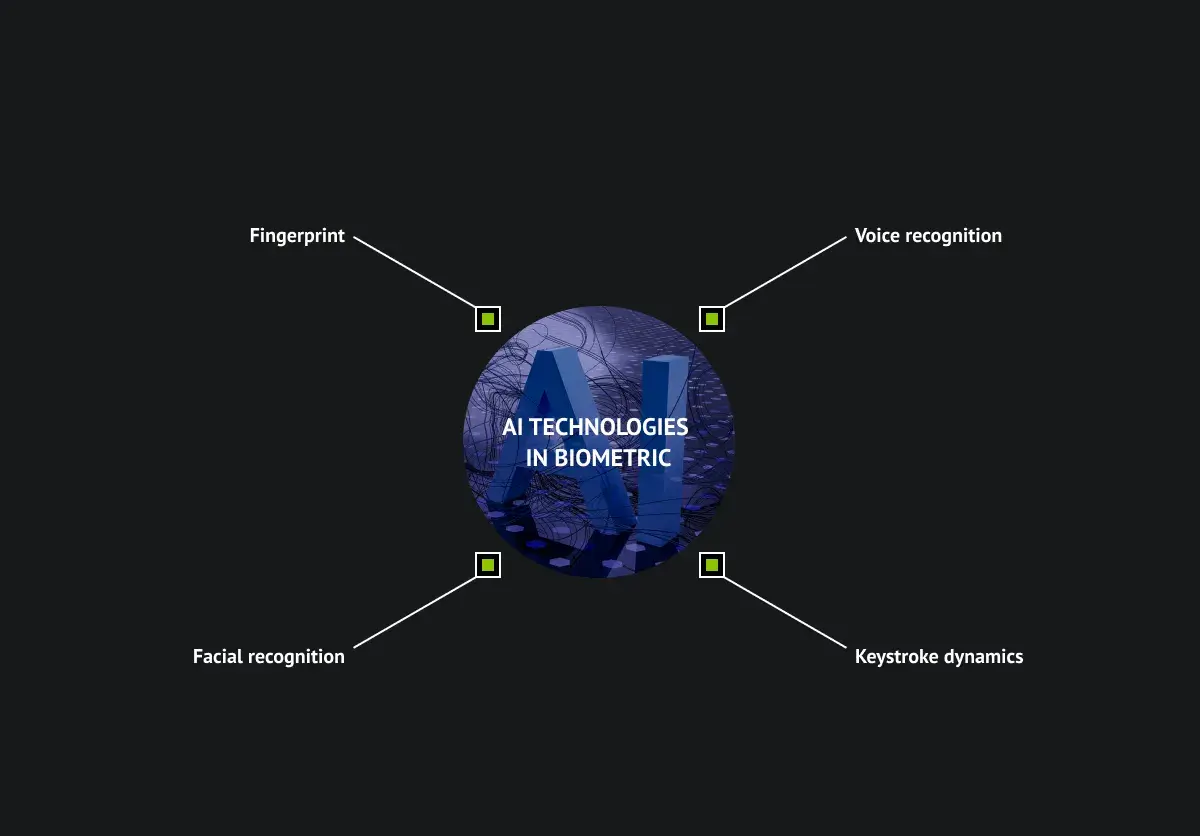
At the same time, facial recognition latest AI technology has become highly accurate, with deep learning models achieving near-human performance. It is used in applications like access control, surveillance, and user authentication. Moreover, new technologies in AI are used in order to prevent fraud and gain traction in authentication. Behavioral biometrics like keystroke dynamics and voice recognition can analyze unique patterns in user behavior and increase the security level. In addition, biometrics, particularly fingerprint and facial recognition, are used in secure payment and financial transactions. They provide a convenient and secure alternative to traditional authentication methods.
The future of biometrics promises to implement new technologies in AI, such as gait recognition, DNA-based biometrics, and brainwave authentication. These innovations will continue to change our reality, determining how we verify identity and interact with technology.
EvenFlow AI: The Clear Example of New Technologies in AI
We know you got a little tired of reading only theory. Let us show you a real example of implementing new technologies in AI in real business. The devabit’s team of Vue.js specialists, remote programmers, web developers, and UI/UX designers has built a platform that helps conveniently book maintenance or repair appointments for your BMW, Honda, and Ford cars.
The EvenFlow AI project is a prime example of how artificial intelligence and data-driven technologies are transforming industries, in this case, the automotive and service sectors.
EvenFlow AI utilizes a latest AI technology, drawing inspiration from revenue management strategies employed in the airline industry. It optimizes the scheduling of maintenance and repair appointments for BMW, Honda, and Ford cars. The platform employs dynamic pricing, a common practice in AI for business applications. By organizing service requests to maximize profit, it reflects the trend of predictive AI analytics used to optimize pricing margins and maximize revenue.
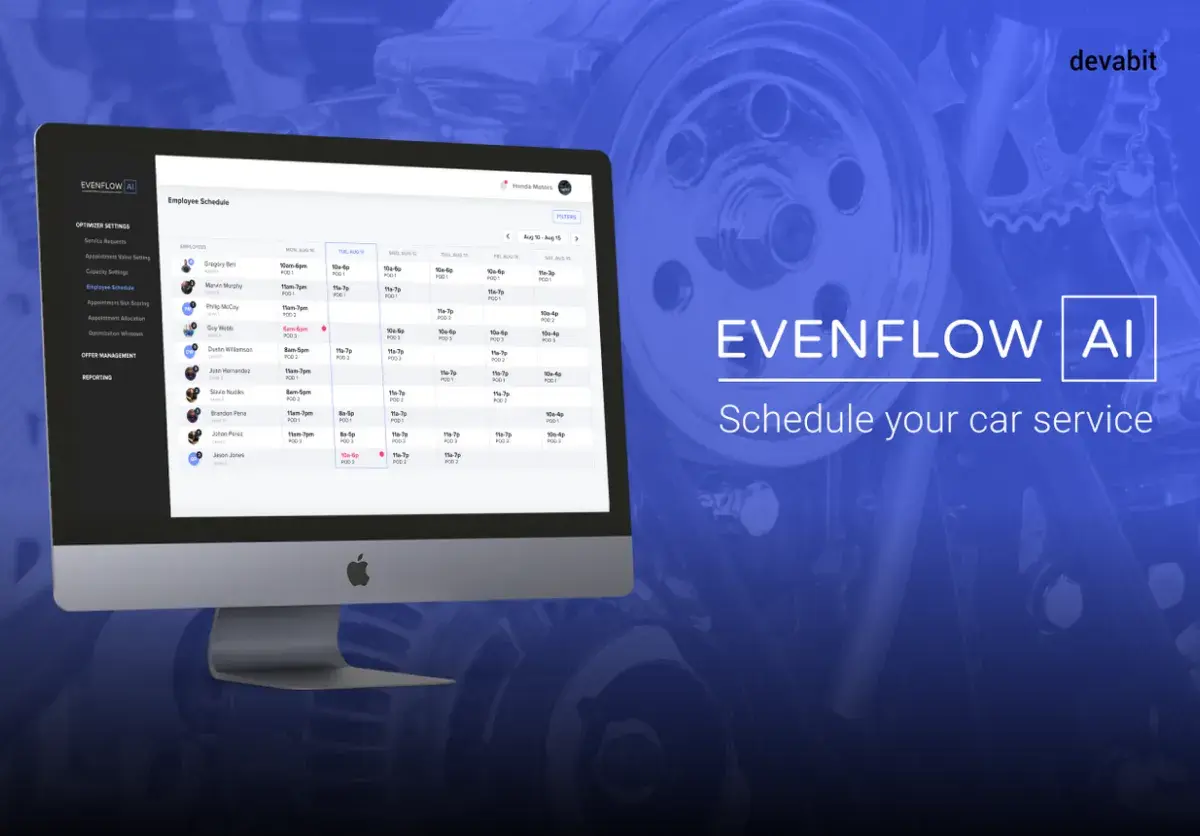
EvenFlow AI prioritizes user convenience, allowing car owners to book appointments at less popular, off-peak times while still gaining incentives. By implementing this feature, businesses enhance the customer experience and simplify the working conditions for personnel. The platform's real-time capacity management is crucial for ensuring efficient use of resources, akin to how AI systems optimize supply chain management in various industries.
In summary, EvenFlow AI clearly demonstrates the integration of AI technologies into a traditional industry to enhance the user experience and boost efficiency. As you can notice, it closely aligns with the key trends discussed earlier and showcases how AI is reshaping businesses and industries across various sectors.
7. New Technologies in AI: Reinforcement Learning
Reinforcement Learning (RL) is a subfield of machine learning that draws inspiration from behavioral psychology. Its history begins with early experiments with neural networks and adaptive control algorithms. RL has played a crucial role in the development of autonomous systems, including self-driving cars and robotics. It enables machines to learn by interacting with their environment and making decisions to maximize rewards. Moreover, RL has made remarkable strides in the gaming industry. It is responsible for AI systems that have defeated human champions in games like Go, chess, and Dota 2.
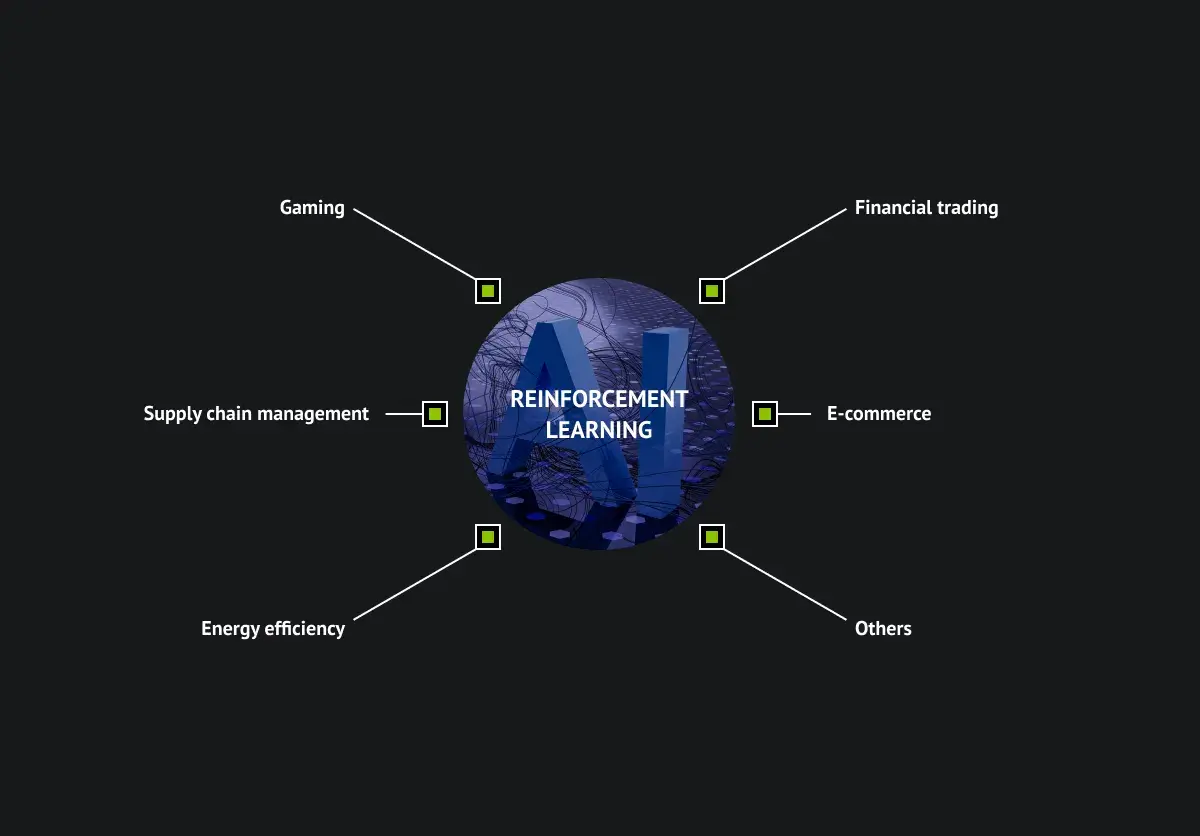
RL is empowering business operations through optimization and automation. It's used in supply chain management, energy efficiency, and financial trading, among other applications. Reinforcement learning enables real-world decision-making, such as optimizing traffic flow in smart cities, managing energy consumption in buildings, and even making personalized recommendations in e-commerce.
The future of RL holds potential in fields like natural language understanding, where machines can learn to interact with humans in more particular ways, and in addressing complex global challenges such as climate change and resource management.
8. New Technologies in AI: Predictive AI Analytics
Predictive AI analytics combines all the advances in data science, machine learning, and statistical modeling. Predictive AI analytics has improved industrial operations, particularly in predictive maintenance. It helps businesses forecast equipment failures and optimize maintenance schedules, reducing downtime and maintenance costs. These new technologies in AI play a crucial role in marketing personalization by enabling businesses to analyze customer behavior and preferences and deliver tailored content and recommendations. This results in higher conversion rates and customer satisfaction.

In the financial sector, predictive AI analytics are employed for risk assessment, fraud detection, and investment portfolio optimization. It enables more informed and timely decision-making, reducing financial risks. Researchers consider predictive AI analytics to be promising in the near future. Advancements in deep learning, real-time data processing, and explainable AI will further broaden its capabilities, making it an excellent tool for informed decision-making.
9. New Technologies in AI: Chatbots and Virtual Assistants
As we have already mentioned before, the concept of AI-powered chatbots and virtual assistants has evolved over several decades, with early chatbots like ELIZA in the 1960s. Nowadays, the main goal of implementing chatbots and virtual assistants into your business is to improve customer service. They provide instant responses to customer inquiries, operate 24/7, and handle routine tasks, resulting in improved customer satisfaction and cost savings for businesses. These new technologies in AI personalize user experiences by analyzing user data and behavior. They recommend products, content, and services, increasing engagement and sales.

Many AI chatbots and virtual assistants are multilingual, breaking down language barriers and facilitating global communication and business expansion. Inside the business, chatbots are simplifying workplace efficiency by automating routine tasks, scheduling meetings, and assisting employees with information retrieval. This contributes to improved productivity and time management.
AI-powered chatbots and virtual assistants have become integral parts of the digital landscape, transforming customer service, personalization, and workplace productivity. As they continue to advance, they will play a more significant role in shaping the way businesses and individuals interact with technology.
10. New Technologies in AI: Sales and Marketing
The appearance of new technologies in AI in the marketing field has constantly changed the way businesses communicate with consumers. From early marketing automation to today’s predictive analytics, new technologies in AI have totally revolutionized the overall marketing process.
Nowadays, AI enables hyper-personalization of marketing campaigns by analyzing customer data and behavior. Personalized content and product recommendations result in higher conversion rates and customer loyalty. AI-powered sales tools provide accurate sales forecasting and lead scoring. They help businesses identify high-value leads and optimize sales strategies, increasing revenue and sales team efficiency. Moreover, marketing automation powered by AI streamlines repetitive tasks, email marketing, and lead nurturing.
Do not forget that the use of the latest AI technology in marketing raises ethical concerns related to data privacy, algorithmic bias, and the responsible use of customer data. Maintaining transparency and adhering to data protection regulations are essential.
11. New Technologies in AI: Data Analytics
Last but not least, the industry that is influenced by the new technologies in AI is the sphere of data analytics. The implementation of the new technologies in AI into data analytics has transformed the way organizations extract insights from vast datasets. This evolution began with traditional data analysis techniques and has now evolved into advanced AI-powered analytics.
AI improves data processing tasks, from data collection and cleansing to transformation and storage. It reduces manual efforts and increases the speed and accuracy of data analytics. Predictive analytics powered by machine learning algorithms are used to forecast trends, customer behavior, and market dynamics. This informs business strategies and helps organizations stay ahead of the competition.

AI-driven data analytics platforms provide personalized data dashboards and reports, so users can receive customized insights relevant to their roles and objectives.
All in all, these innovations will further empower organizations to unlock the full potential of their data.
+ BONUS TREND: AI 3D MODELING
AI-powered 3D modeling is rapidly evolving from a helpful plugin into a full creative partner in digital production. Did you know that modern systems can generate high-quality meshes, apply realistic materials, and even suggest optimized topology from simple prompts, sketches, or image references? Sounds truly impressive, right? This, in turn, transforms weeks of manual work into hours, enabling 3D artists to prototype and test ideas efficiently. Beyond asset creation, AI is integrated into the 3D modeling workflow, assisting with tasks such as real-time optimization across platforms.
+ BONUS TREND: AI IN THE AUTOMOTIVE INDUSTRY
In the automotive sector, AI has moved far beyond autonomous driving experiments and is now quietly reshaping the full industry. For instance, manufacturers use AI to optimize design and engineering, simulate performance under thousands of conditions, and predict component failures before they happen. For drivers, AI enables advanced driver-assistance systems, intelligent infotainment, and highly personalized in-car experiences that adapt to behavior and preferences over time. As vehicles become rolling software platforms, vehicle service centers, drivers, and manufacturers benefit from automotive agentic AI, AI DMS, and AI-powered predictive maintenance solutions.

Implement New Technologies in AI to Your Business with devabit!
As you can see, new technologies in AI are influencing various industries in our lives. For individuals, they provide an excellent opportunity to improve life conditions, while for businesses, implementing new technologies in AI is the way to increase profits and enhance the customer experience. Do not miss such a chance to develop or improve your business. Choose devabit for implementing new technologies in AI into your business and building your AI project.
At devabit, you can find highly experienced web developers, UI/UX designers, Android and iOS programmers, PHP specialists, and more professionals that will assist you in creating your AI project. So, when you are ready to realize the full potential of AI for your business, remember that devabit is here as your trusted partner. Together, we can turn the latest AI technology into actionable strategies, helping your business thrive in the digital age.
Do not wait; contact us today in order to shape the future of your business with AI!
Recent Publications
Don't miss out! Click here to stay in touch.
Discover more

Relevant Articles View all categories
View all categories CONNECT WITH US WE’RE READY
TO TALK OPPORTUNITIES
THANK YOU! WE RECEIVED YOUR MESSAGE.
Sorry
something went wrong




